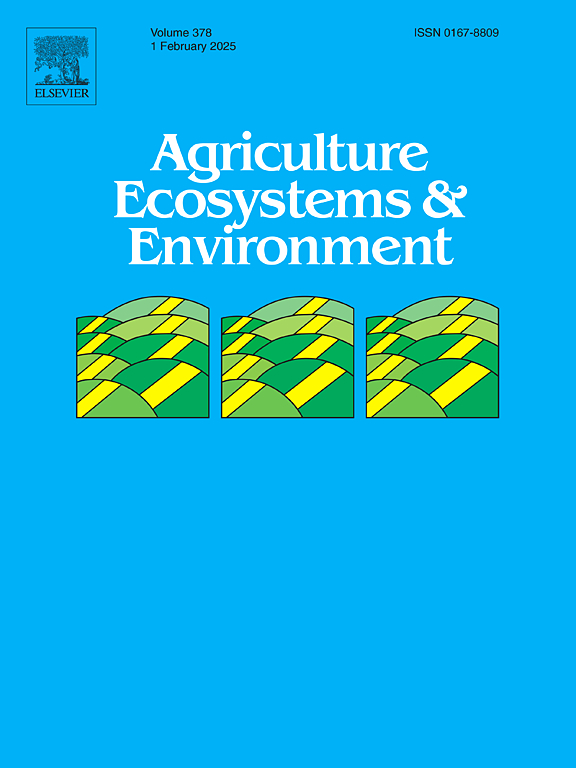Balancing bats and agriculture: Investigating the effects of agricultural management practices on bat species diversity in mountain ecosystems
IF 6
1区 农林科学
Q1 AGRICULTURE, MULTIDISCIPLINARY
引用次数: 0
Abstract
Changes in agricultural land use and farming practices have been recognized as significant drivers of biodiversity loss, especially when they involve intensive monoculture, excessive pesticide use, overgrazing by livestock, and habitat destruction. These practices not only reduce plant and insect diversity but also impact vertebrates, including bats. We investigated the effect of natural structural elements and intensity of agricultural practices on bat richness and activity across open mountain agricultural areas. The variables considered included the total area of natural structural elements (e.g., hedgerows, trees), the management intensity index, manure hill presence, grazing pressure, and mowing frequency. We recorded bat activity at 47 sites using passive acoustic monitoring, and classified bat species into foraging guilds based on their foraging strategies. We analyzed data using generalized linear mixed models and linear models, respectively, to assess the activity of foraging guilds and species richness in relation to agricultural intensity and landscape variables. We found that natural structural elements positively influenced bat diversity, particularly short-range echolocators and low foragers. Grazing and mowing practices showed mixed impacts on bat diversity, while the presence of manure hills displayed a negative correlation with most bat guilds. This study underscores the need for nuanced approaches to agricultural management that consider the complex effects on bat species diversity. It highlights the importance of maintaining natural structural elements and promoting extensive grazing and mowing practices. These findings contribute to a holistic understanding of how agricultural practices and natural structural elements can alter bat populations’ activity, ultimately affecting the overall biodiversity in mountain agricultural landscapes.
平衡蝙蝠与农业:调查农业管理措施对山地生态系统中蝙蝠物种多样性的影响
农业土地利用和耕作方式的变化已被认为是生物多样性丧失的重要驱动因素,特别是当它们涉及集约化单一栽培、过度使用农药、牲畜过度放牧和栖息地破坏时。这些做法不仅减少了植物和昆虫的多样性,还影响了包括蝙蝠在内的脊椎动物。研究了自然结构要素和农业实践强度对山地开阔农业区蝙蝠丰富度和活动的影响。考虑的变量包括自然结构要素(如树篱、树木)的总面积、管理强度指数、粪肥丘的存在、放牧压力和刈割频率。利用被动声学监测方法记录了47个地点的蝙蝠活动,并根据蝙蝠的觅食策略将其划分为觅食行会。我们分别使用广义线性混合模型和线性模型分析数据,以评估觅食行会的活动和物种丰富度与农业强度和景观变量的关系。我们发现自然结构因素对蝙蝠多样性有积极的影响,特别是短程回声定位器和低觅食者。放牧和刈割对蝙蝠多样性的影响呈混合影响,而粪肥丘的存在与大多数蝙蝠行会呈负相关。这项研究强调需要细致入微的农业管理方法,考虑到对蝙蝠物种多样性的复杂影响。它强调了保持自然结构元素和促进广泛放牧和割草做法的重要性。这些发现有助于全面了解农业实践和自然结构因素如何改变蝙蝠种群的活动,最终影响山地农业景观的整体生物多样性。
本文章由计算机程序翻译,如有差异,请以英文原文为准。
求助全文
约1分钟内获得全文
求助全文
来源期刊

Agriculture, Ecosystems & Environment
环境科学-环境科学
CiteScore
11.70
自引率
9.10%
发文量
392
审稿时长
26 days
期刊介绍:
Agriculture, Ecosystems and Environment publishes scientific articles dealing with the interface between agroecosystems and the natural environment, specifically how agriculture influences the environment and how changes in that environment impact agroecosystems. Preference is given to papers from experimental and observational research at the field, system or landscape level, from studies that enhance our understanding of processes using data-based biophysical modelling, and papers that bridge scientific disciplines and integrate knowledge. All papers should be placed in an international or wide comparative context.
 求助内容:
求助内容: 应助结果提醒方式:
应助结果提醒方式:


